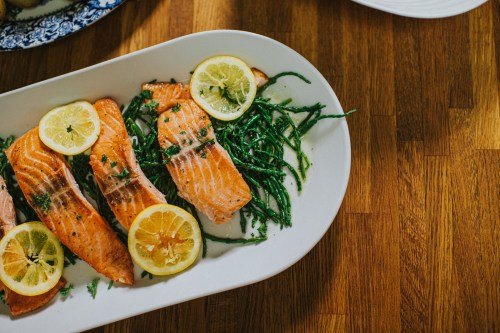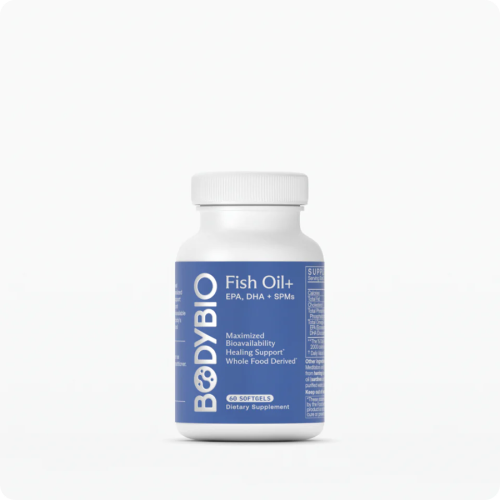Our editors independently select these products. Making a purchase through our links may earn Well+Good a commission
Whether from social media, our healthcare providers, or online articles, recommendations to consume more fish, particularly fatty fish, seem to come from every direction these days. If you’re wondering what’s at the root of this, this guidance is largely related to the fish oil found in these fatty seafood options. But what makes fish oil so special?
Fish oil, a liquid gold for some, contains particularly hard-to-come-by omega-3 fatty acids that serve a variety of important roles throughout the body. Read on to discover what these benefits are, how they differ from plant-based omega-3s, and some of the best (and tastiest) ways to get more fish oil into your diet.
How Fish Oil Benefits the Body
When it comes to omega-3 fatty acids, there are three main types: alpha-linolenic acid (ALA), docosahexaenoic acid (DHA), and eicosapentaenoic acid (EPA). “These fatty acids are considered ‘essential’ because they cannot be produced by our bodies, meaning we must obtain them through our diet or omega-3 supplements,” explains Megan Huff, RD, registered dietitian and owner of Nutrition by Megan.
Each of these unsaturated fats carries out specific tasks1 in the body. ALA serves as an energy source and precursor to DHA and EPA, while DHA plays an integral role in brain and eye function, and (alongside EPA) reduces bodily inflammation2 and promotes heart health.
“Key benefits also include lowering LDL3 (low-density lipoprotein or ‘bad’) cholesterol, reducing blood pressure4, and helping regulate mood5,” Huff adds. These fats are also effective prebiotics (or food) for beneficial bacteria6 in the gut microbiome and aid in healthy fetal brain development7.
“Additionally, studies have found benefits of omega-3s in reducing stiffness of rheumatoid arthritis8 and risk of Alzheimer’s disease and dementia9,” shares Courtney Pelitera, MS, RD, CNSC, registered dietitian at Top Nutrition Coaching.
How Much Fish Oil Do You Need?
ALA is typically found in plant-based fat sources like walnuts, chia seeds, flax, and soybeans, whereas rich sources of DHA and EPA include fatty fish, including sardines, anchovies, salmon, and mackerel. And though ALA can convert into DHA and EPA in the body, this happens at a rate of only 15 percent or less10. Plus, research illustrates11 that while Americans are generally meeting their daily ALA needs, they aren’t getting enough of EPA and DHA. Herein lies the ‘why’ behind the health community’s obsession with fish oil.
“The National Institutes of Health12 recommends that adult women aim for 1.1 grams of ALA per day, while men should aim for 1.6 grams per day,” explains Huff. However, because of ALA’s EPA and DHA conversion inefficiency, the Dietary Guidelines for Americans13 recommends adults consume an additional 250 to 500 milligrams (mg) of DHA and EPA (combined) daily. Meanwhile, studies focused specifically on omega-3 intake for improved heart health outcomes recommend consuming between two14 and three15 grams of DHA and EPA per day.
The TL;DR
Despite these confusing recommendations, as long as you’re not exceeding the upper limit of five grams of combined DHA and EPA16 per day (which could result in unwanted outcomes like bleeding or atrial fibrillation17), you should be reaping the best benefits of these fats.
6 Ways to Get More Fish Oil Into Your Diet
When focused on consuming at least 250 to 500 mg of DHA and EPA per day, your options are (generally) either fatty fish or dietary supplements. While algae is one example of a plant-based source of these specific omega-3s, it’s still usually most accessible in supplement form. With this in mind, here are some of the most effective options18 for boosting your DHA and EPA intake.

Salmon
The brilliant color of salmon filets is easy to spot at the fish counter, and one of the most popular seafoods nationwide, unsurprisingly related to their high fish oil content. You’ll find somewhere between 950 and 1,830 mg of combined EPA and DHA per three-ounce serving. “Salmon is also low in saturated fat and a great source of lean protein, vitamin B12, and vitamin D. Vitamin B1219 is important for the production of red blood cells, while vitamin D supports bone health20,” says Huff. Plus, there are so many tasty ways to enjoy this fish. “My favorite way to consume this fish is simply baked with some salt and pepper alongside roasted vegetables,” adds Pelitera. It’s also delicious added to grain bowls, stir fries, soups, pastas, or sandwiches.

Sardines
As a more eco-friendly (and plenty delicious) seafood, sardines are starting to gain the popular attention they deserve. These small fish reproduce quickly, making commercial harvest less disruptive to the greater marine ecosystem and more sustainable. However, sardines’ small size also yields incredible nutrition. Because they’re packaged with their bones and cartilage intact (don’t worry, they dissolve before you’re able to eat them), these tiny fish are super high21 in calcium and vitamin D as well as zinc, iron, potassium, B vitamins like biotin, and (of course) omega-3s to support bone, immune, heart, and metabolic health. Plus, three ounces of sardines contain approximately 1,200 mg of DHA and EPA. They make for super tasty tuna-like seafood salads, pasta additions, or seafood stew ingredients.

Mackerel
Like sardines, mackerel fall lower on the marine food chain, translating to lower environmental impact and lower levels of mercury22. However, it’s important to avoid king mackerel at the fish counter to reap these benefits, as this variety is at the top of the food chain. Instead, look for mackerel that are small in size or the ‘chub’ species (these are what you’ll most often find in the tinned fish aisle). This less-popular fish is also super nutrient-dense with around 1,200 mg of omegas per three ounces as well as plenty of vitamin D, magnesium, selenium, copper, iodine, and B vitamins to support bone, heart, immune, thyroid, and metabolic health. Mackerel is yummy tossed into salads, added to sandwiches, or grilled with veggies.

Oysters
Few things are as lovely as a dozen raw oysters when dining out (in my opinion). And aside from their briny, fresh flavor, oysters are nutritional powerhouses. Three ounces contains around 670 mg of combined DHA and EPA, as well as plenty of zinc, selenium, copper, vitamin B12, iron, and manganese to champion immune health, red blood cell production, and strong bones. If not enjoyed raw on the half-shell, oysters can be made into tasty stews, pastas, or baked with herbs and seasonings.

Herring
Though a less-common seafood grab for many Americans, herring is a Scandinavian favorite that has so much to offer both nutritionally and culinarily. There’s an impressive 1,700 mg of combined DHA and EPA in three ounces of this fish, as well as plenty of vitamin D, calcium, magnesium, and B vitamins to support bone, heart, immune, and metabolic health. You’ll most commonly find herring canned, pickled, or smoked at the grocery store, where it can then be made into a Scandinavian-inspired fish salad served atop hearty whole grain crackers, sautéed with aromatic veggies, or added to soups.

Dietary Supplements
And finally, if you’re not a fish fan, are plant-based, or otherwise can’t consume enough fish oil through whole foods, a reputable dietary supplement can be a smart purchase. BodyBio’s Fish Oil+ is an excellent option providing 430 mg of omega-3s per serving (380 mg of which are DHA and EPA) from whole fish sources. This dosage allows you wiggle room to enjoy whole food fish oil sources while still meeting your daily needs, plus this option is third-party tested for purity, safety, and effectiveness. “Because supplements are not regulated by the Food and Drug Administration23 (FDA), this is important to note,” explains Pelitera.
Sponsored by BodyBio
- Innis, Sheila M. “Omega-3 Fatty Acid Biochemistry: Perspectives from Human Nutrition.” Military Medicine, vol. 179, no. 11S, Nov. 2014, pp. 82–87, academic.oup.com/milmed/article/179/suppl_11/82/4210215, https://doi.org/10.7205/milmed-d-14-00147.
↩︎ - Banaszak, Michalina, et al. “Role of Omega-3 Fatty Acids Eicosapentaenoic (EPA) and Docosahexaenoic (DHA) as Modulatory and Anti-Inflammatory Agents in Noncommunicable Diet-Related Diseases – Reports from the Last 10 Years.” Clinical Nutrition ESPEN, vol. 63, 1 Oct. 2024, pp. 240–258, https://doi.org/10.1016/j.clnesp.2024.06.053.
↩︎ - Wang, Tianjiao, et al. “Association between Omega‐3 Fatty Acid Intake and Dyslipidemia: A Continuous Dose–Response Meta‐Analysis of Randomized Controlled Trials.” Journal of the American Heart Association, vol. 12, no. 11, 2 June 2023, https://doi.org/10.1161/jaha.123.029512.
↩︎ - Zhang, Xin, et al. “Omega‐3 Polyunsaturated Fatty Acids Intake and Blood Pressure: A Dose‐Response Meta‐Analysis of Randomized Controlled Trials.” Journal of the American Heart Association, vol. 11, no. 11, 7 June 2022, https://doi.org/10.1161/jaha.121.025071.
↩︎ - Mehdi, Seema et al. “Omega-3 Fatty Acids Supplementation in the Treatment of Depression: An Observational Study.” Journal of personalized medicine vol. 13,2 224. 27 Jan. 2023, doi:10.3390/jpm13020224 ↩︎
- Vijay, Amrita et al. “The prebiotic effects of omega-3 fatty acid supplementation: A six-week randomised intervention trial.” Gut microbes vol. 13,1 (2021): 1-11. doi:10.1080/19490976.2020.1863133 ↩︎
- Devarshi, Prasad P et al. “Maternal Omega-3 Nutrition, Placental Transfer and Fetal Brain Development in Gestational Diabetes and Preeclampsia.” Nutrients vol. 11,5 1107. 18 May. 2019, doi:10.3390/nu11051107 ↩︎
- Cordingley, Dean M, and Stephen M Cornish. “Omega-3 Fatty Acids for the Management of Osteoarthritis: A Narrative Review.” Nutrients vol. 14,16 3362. 16 Aug. 2022, doi:10.3390/nu14163362 ↩︎
- Wei, Bao-Zhen et al. “The Relationship of Omega-3 Fatty Acids with Dementia and Cognitive Decline: Evidence from Prospective Cohort Studies of Supplementation, Dietary Intake, and Blood Markers.” The American journal of clinical nutrition vol. 117,6 (2023): 1096-1109. doi:10.1016/j.ajcnut.2023.04.001 ↩︎
- Marija Takić, et al. “Current Insights into the Effects of Dietary α-Linolenic Acid Focusing on Alterations of Polyunsaturated Fatty Acid Profiles in Metabolic Syndrome.” International Journal of Molecular Sciences, vol. 25, no. 9, 30 Apr. 2024, pp. 4909–4909, www.ncbi.nlm.nih.gov/pmc/articles/PMC11084241/, https://doi.org/10.3390/ijms25094909. Accessed 22 Aug. 2024.
↩︎ - Froyen, Erik, and Zahraa Maarafi. “The Consumption of Omega-3 Fatty Acids in American Adults.” Current Developments in Nutrition vol. 6,Suppl 1 902. 14 Jun. 2022, doi:10.1093/cdn/nzac067.022 ↩︎
- National Institutes of Health. “Office of Dietary Supplements - Omega-3 Fatty Acids.” Nih.gov, 15 Feb. 2023, ods.od.nih.gov/factsheets/Omega3FattyAcids-HealthProfessional/.
↩︎ - USDA. “Dietary Guidelines for Americans 2020-2025.” USDA, Dec. 2020.
↩︎ - Wang, Tianjiao, et al. “Association between Omega‐3 Fatty Acid Intake and Dyslipidemia: A Continuous Dose–Response Meta‐Analysis of Randomized Controlled Trials.” Journal of the American Heart Association, vol. 12, no. 11, 2 June 2023, https://doi.org/10.1161/jaha.123.029512.
↩︎ - Zhang, Xin, et al. “Omega‐3 Polyunsaturated Fatty Acids Intake and Blood Pressure: A Dose‐Response Meta‐Analysis of Randomized Controlled Trials.” Journal of the American Heart Association, vol. 11, no. 11, 7 June 2022, https://doi.org/10.1161/jaha.121.025071.
↩︎ - Rice, Harry. Food and Drug Administration. June. 2019. ↩︎
- Huh, Ji Hye, and Sang-Ho Jo. “Omega-3 fatty acids and atrial fibrillation.” The Korean journal of internal medicine vol. 38,3 (2023): 282-289. doi:10.3904/kjim.2022.266 ↩︎
- National Institutes of Health. “Office of Dietary Supplements - Omega-3 Fatty Acids.” Nih.gov, 15 Feb. 2023, ods.od.nih.gov/factsheets/Omega3FattyAcids-HealthProfessional/.
↩︎ - National Institutes of Health. “Office of Dietary Supplements - Vitamin B12.” Nih.gov, National Institutes of Health, 27 Feb. 2024, ods.od.nih.gov/factsheets/VitaminB12-HealthProfessional/.
↩︎ - LeBoff, Meryl S, et al. “Effects of Supplemental Vitamin D on Bone Health Outcomes in Women and Men in the VITamin D and OmegA‐3 TriaL (VITAL).” Journal of Bone and Mineral Research, vol. 35, no. 5, 30 Jan. 2020, pp. 883–893, https://doi.org/10.1002/jbmr.3958.
↩︎ - Santos, Heitor O et al. “Eating more sardines instead of fish oil supplementation: Beyond omega-3 polyunsaturated fatty acids, a matrix of nutrients with cardiovascular benefits.” Frontiers in nutrition vol. 10 1107475. 14 Apr. 2023, doi:10.3389/fnut.2023.1107475 ↩︎
- What Is Mercury? California Office of Environmental Health Hazard Assessment. ↩︎
- FDA. “Dietary Supplements.” Fda.gov, 6 Mar. 2023, www.fda.gov/food/dietary-supplements.
↩︎
Sign Up for Our Daily Newsletter
Get all the latest in wellness, trends, food, fitness, beauty, and more delivered right to your inbox.
Got it, you've been added to our email list.










